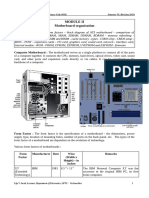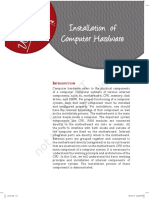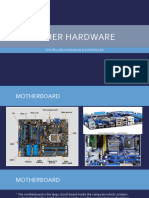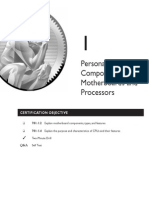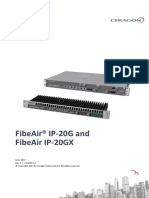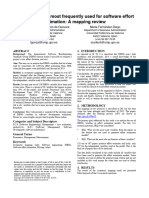9/28/2019 Computer form factor - Wikipedia
Computer form factor
In computing, the form factor is the specification of a motherboard – the dimensions, power supply type, location of mounting holes, number of ports on the
back panel, etc. Specifically, in the IBM PC compatible industry, standard form factors ensure that parts are interchangeable across competing vendors and
generations of technology, while in enterprise computing, form factors ensure that server modules fit into existing rackmount systems. Traditionally, the most
significant specification is for that of the motherboard, which generally dictates the overall size of the case. Small form factors have been developed and
implemented.
Contents
Overview of form factors
Comparisons
Tabular information
Maximum number of expansion card slots
Visual examples of different form factors
PC/104 and EBX
Mini PC
Examples
See also
References
External links
Overview of form factors
A PC motherboard is the main circuit board within a typical desktop computer, laptop or server. Its main functions are as follows:
To serve as a central backbone to which all other modular parts such as CPU, RAM, and hard drives can be attached as required to create a computer
To be interchangeable (in most cases) with different components (in particular CPU and expansion cards) for the purposes of customization and upgrading
To distribute power to other circuit boards
To electronically co-ordinate and interface the operation of the components
https://en.wikipedia.org/wiki/Computer_form_factor 1/8
�9/28/2019 Computer form factor - Wikipedia
As new generations of components have been developed, the standards of motherboards
have changed too. For example, the introduction of AGP and, more recently, PCI Express
have influenced motherboard design. However, the standardized size and layout of
motherboards have changed much more slowly and are controlled by their own
standards. The list of components required on a motherboard changes far more slowly
than the components themselves. For example, north bridge microchips have changed
many times since their introduction with many manufacturers bringing out their own
versions, but in terms of form factor standards, provisions for north bridges have
remained fairly static for many years. Comparison of some common motherboard form factors
Although it is a slower process, form factors do evolve regularly in response to changing
demands. IBM's long-standing standard, AT (Advanced Technology), was superseded in 1995 by the current industry standard ATX (Advanced Technology
Extended), which still governs the size and design of the motherboard in most modern PCs. The latest update to the ATX standard was released in 2007. A
divergent standard by chipset manufacturer VIA called EPIA (also known as ITX, and not to be confused with EPIC) is based upon smaller form factors and its own
standards.
Differences between form factors are most apparent in terms of their intended market sector, and involve variations in size, design compromises and typical
features. Most modern computers have very similar requirements, so form factor differences tend to be based upon subsets and supersets of these. For example, a
desktop computer may require more sockets for maximum flexibility and many optional connectors and other features on board, whereas a computer to be used in
a multimedia system may need to be optimized for heat and size, with additional plug-in cards being less common. The smallest motherboards may sacrifice CPU
flexibility in favor of a fixed manufacturer's choice.
Comparisons
Tabular information
https://en.wikipedia.org/wiki/Computer_form_factor 2/8
�9/28/2019 Computer form factor - Wikipedia
Form
Originated Max. size[info 1] Notes
factor width × depth (typical usage, Market adoption, etc.)
Obsolete, see Industry Standard Architecture. The IBM Personal Computer XT was the successor to the
8.5 × 11 in
XT IBM 1983 original IBM PC, its first home computer. As the specifications were open, many clone motherboards
216 × 279 mm
were produced and it became a de facto standard.
AT 12 × 11–13 in Obsolete, see Industry Standard Architecture. Created by IBM for the IBM Personal Computer/AT, an
(Advanced IBM 1984 305 × 279– Intel 80286 machine. Also known as Full AT, it was popular during the era of the Intel 80386
Technology) 330 mm microprocessor. Superseded by ATX.
8.5 × 10–13 in
IBM's 1985 successor to the AT motherboard. Functionally equivalent to the AT, it became popular due to
Baby-AT IBM 1985 216 × 254–
its significantly smaller size.
330 mm
12 × 9.6 in Created by Intel in 1995. As of 2017, it is the most popular form factor for commodity motherboards.
ATX Intel 1995
305 × 244 mm Typical size is 9.6 × 12 in although some companies extend that to 10 × 12 in.
Created by the Server System Infrastructure (SSI) forum. Derived from the EEB and ATX specifications.
12 × 10.5 in
SSI CEB SSI This means that SSI CEB motherboards have the same mounting holes and the same IO connector area
305 × 267 mm
as ATX motherboards.
Created by the Server System Infrastructure (SSI) forum. Derived from the EEB and ATX specifications.
12 × 13 in
SSI EEB SSI This means that SSI CEB motherboards have the same mounting holes and the same IO connector area
305 × 330 mm
as ATX motherboards, but SSI EEB motherboards do not.
16.2 × 13 in
SSI MEB SSI Created by the Server System Infrastructure (SSI) forum. Derived from the EEB and ATX specifications.
411 × 330 mm
A smaller variant of the ATX form factor (about 25% shorter). Compatible with most ATX cases, but has
9.6 × 9.6 in
microATX 1996 fewer slots than ATX, for a smaller power supply unit. Very popular for desktop and small form factor
244 × 244 mm
computers as of 2017.
Mini-ATX is considerably smaller than Micro-ATX. Mini-ATX motherboards were designed with MoDT
5.9 × 5.9 in
Mini-ATX AOpen 2005 (Mobile on Desktop Technology) which adapt mobile CPUs for lower power requirement, less heat
150 × 150 mm
generation and better application capability.
9.0 × 7.5 in
A subset of microATX developed by Intel in 1999. Allows more flexible motherboard design, component
FlexATX Intel 1999 228.6 × 190.5 mm
positioning and shape. Can be smaller than regular microATX.
max.
6.7 × 6.7 in
Mini-ITX VIA 2001 170 × 170 mm A small, highly integrated form factor, designed for small devices such as thin clients and set-top boxes.
max.
4.7 × 4.7 in Targeted at smart digital entertainment devices such as PVRs, set-top boxes, media centers and Car
Nano-ITX VIA 2003
120 × 120 mm PCs, and thin devices.
3.9 × 2.8 in
Pico-ITX VIA 2007 100 × 72 mm
max.
https://en.wikipedia.org/wiki/Computer_form_factor 3/8
�9/28/2019 Computer form factor - Wikipedia
Form
Originated Max. size[info 1] Notes
factor width × depth (typical usage, Market adoption, etc.)
2.953 × 1.772 in
Mobile-ITX VIA 2007
75 × 45 mm
Neo-ITX VIA 2012 170 × 85 × 35 mm Used in the VIA Android PC
Smaller than Mini-ITX, but bigger than the NUC, this board is used in small form factor computers, using
Mini-STX Intel 2015 147 x 140 mm
a socketed intel core processor and SO-DIMMS.
A standard proposed by Intel as a successor to ATX in the early 2000s, according to Intel the layout has
BTX better cooling. BTX Boards are flipped in comparison to ATX Boards, so a BTX or MicroBTX Board
12.8 × 10.5 in needs a BTX case, while an ATX style board fits in an ATX case. The RAM slots and the PCI slots are
(Balanced
Intel 2004 325 × 267 mm parallel to each other.
Technology
max.
Extended) Processor is placed closest to the fan. May contain a CNR board.
10.4 × 10.5 in
MicroBTX MicroBTX (also called uBTX) is a computer motherboard form factor. A microBTX is 10.4 × 10.5 in (264
Intel 2004 264 × 267 mm
(or uBTX) × 267 mm) and can support up to four expansion slots.
max.
8.0 × 10.5 in
PicoBTX Intel 2004 203 × 267 mm
max.
8.0 × 9.6 in
DTX AMD 2007 200 × 244 mm
max.
smartModule Digital-Logic 66 × 85 mm Used in embedded systems and single board computers. Requires a baseboard.
ETX Kontron 95 × 114 mm Used in embedded systems and single board computers. Requires a baseboard.
COM
Used in embedded systems and single board computers. Requires a carrier board. Formerly referred to
Express PICMG 95 × 125 mm
as ETXexpress by Kontron.
Basic
COM
Used in embedded systems and single board computers. Requires a carrier board. Formerly referred to
Express PICMG 95 × 95 mm
as microETXexpress by Kontron.
Compact
Luke
A general-purpose "eco-conscious" mass-volume standard based around re-use of legacy PCMCIA. Has
Kenneth
EOMA68 85.6 × 54 mm two variants: Type I (3.3mm high) and Type II (5.0mm high). Does not require a carrier board if the user-
Casson
facing end provides power.
Leighton
Used in embedded systems and single board computers. Requires a carrier board. Formerly referred to
COM
PICMG 55 × 84 mm as nanoETXexpress by Kontron. Also known as COM Express Ultra and adheres to pin-outs Type 1 or
Express Mini
Type 10[1]
https://en.wikipedia.org/wiki/Computer_form_factor 4/8
�9/28/2019 Computer form factor - Wikipedia
Form
Originated Max. size[info 1] Notes
factor width × depth (typical usage, Market adoption, etc.)
CoreExpress SFF-SIG 58 × 65 mm Used in embedded systems and single board computers. Requires a carrier board.
Used in rackmount server systems. Typically used for server-class type motherboards with dual
Extended 12 × 13 in
Unknown processors and too much circuitry for a standard ATX motherboard. The mounting hole pattern for the
ATX (EATX) 305 × 330 mm
upper portion of the board matches ATX.
Enhanced
13.68 × 13 in Used in rackmount server systems. Typically used for server-class type motherboards with dual
Extended Supermicro
347 × 330 mm processors and too much circuitry for a standard E.ATX motherboard.
ATX (EEATX)
9 × 11–13 in Based on a design by Western Digital, it allowed smaller cases than the AT standard, by putting the
Western
LPX 229 × 279– expansion card slots on a Riser card. Used in slimline retail PCs. LPX was never standardized and
Digital
330 mm generally only used by large OEMs.
8–9 × 10–11 in
Western
Mini-LPX 203–229 × 254– Used in slimline retail PCs.
Digital
279 mm
PC/104
PC/104 Consortium 3.8 × 3.6 in Used in embedded systems. AT Bus (ISA) architecture adapted to vibration-tolerant header connectors.
1992
PC/104
PC/104-Plus Consortium 3.8 × 3.6 in Used in embedded systems. PCI Bus architecture adapted to vibration-tolerant header connectors.
1997
PC/104
PCI/104- Used in embedded systems.
Consortium 3.8 × 3.6 in
Express PCI Express architecture adapted to vibration-tolerant header connectors.
2008
PC/104
Used in embedded systems.
PCIe/104 Consortium 3.8 × 3.6 in
PCI/104-Express without the legacy PCI bus.
2008
8–9 × 10–13.6 in
A low-profile design released in 1997. It also incorporated a riser for expansion cards,[2] and never
NLX Intel 1999 203–229 × 254–
became popular.
345 mm
TQ-
UTX Components 88 × 108 mm Used in embedded systems and IPCs. Requires a baseboard.
2001
14 × 16.75 in
WTX Intel 1998 A large design for servers and high-end workstations featuring multiple CPUs and hard drives.
355.6 × 425.4 mm
16.48 × 13 in
SWTX Supermicro A proprietary design for servers and high-end workstations featuring multiple CPUs.
418 × 330 mm
https://en.wikipedia.org/wiki/Computer_form_factor 5/8
�9/28/2019 Computer form factor - Wikipedia
Form
Originated Max. size[info 1] Notes
factor width × depth (typical usage, Market adoption, etc.)
13.6 × 15 in A large design by EVGA currently featured on two motherboards; the eVGA SR2 and SRX. Intended for
HPTX EVGA 2008
345.44 × 381 mm use with multiple CPUs. Cases require 9 expansion slots to contain this form-factor.
XTX 2005 95 × 114 mm Used in embedded systems. Requires a base.
1. For boards which take expansion slots, the length of the expansion card aligns with the depth of the system board. The case may support cards longer than
the depth of the mainboard.
Maximum number of expansion card slots
ATX case compatible:
Specification Number
HPTX 9
ATX/EATX/SSI EEB/SSI CEB 7
MicroATX 4
FlexATX 3
DTX/Mini-DTX 2
Mini-ITX 1
Visual examples of different form factors
Different form factors
https://en.wikipedia.org/wiki/Computer_form_factor 6/8
�9/28/2019 Computer form factor - Wikipedia
ATX mini-ITX Pico-ITX
(Abit KT7) (VIA EPIA 5000AG) (VIA EPIA PX10000G)
PC/104 and EBX
PC/104 is an embedded computer standard which defines both a form factor and computer bus. PC/104 is intended for embedded computing environments. Single
board computers built to this form factor are often sold by COTS vendors, which benefits users who want a customized rugged system, without months of design
and paper work.
The PC/104 form factor was standardized by the PC/104 Consortium in 1992.[3] An IEEE standard corresponding to PC/104 was drafted as IEEE P996.1, but never
ratified.[4]
The 5.75 × 8.0 in Embedded Board eXpandable (EBX) specification, which was derived from Ampro's proprietary Little Board form-factor, resulted from a
collaboration between Ampro and Motorola Computer Group.
As compared with PC/104 modules, these larger (but still reasonably embeddable) SBCs tend to have everything of a full PC on them, including application
oriented interfaces like audio, analog, or digital I/O in many cases. Also it's much easier to fit Pentium CPUs, whereas it's a tight squeeze (or expensive) to do so on
a PC/104 SBC. Typically, EBX SBCs contain: the CPU; upgradeable RAM subassemblies (e.g., DIMM); Flash memory for solid state drive; multiple USB, serial, and
parallel ports; onboard expansion via a PC/104 module stack; off-board expansion via ISA and/or PCI buses (from the PC/104 connectors); networking interface
(typically Ethernet); and video (typically CRT, LCD, and TV).
Mini PC
Mini PC is a PC small form factor very close in size to an external CD or DVD drive. Mini PCs have proven popular for use as HTPCs.
Examples
https://en.wikipedia.org/wiki/Computer_form_factor 7/8
�9/28/2019 Computer form factor - Wikipedia
AOpen XC mini
Apple Mac mini
Intel NUC
Gigabyte Brix
Zotac ZBOX
Asus Vivopc
See also
Hard-disk-drive form factors
Small form factor
References
1. "Atom module shrinks to nano size" (https://archive.is/20120524152952/http://www.windowsfordevices.com/c/a/News/Atom-module-shrinks-to-nano-size/).
Archived from the original (http://www.windowsfordevices.com/c/a/News/Atom-module-shrinks-to-nano-size) on 2012-05-24. Retrieved 2009-12-30.
2. "Form Factors Rev 1.3 :: NLX" Motherboards.org (http://www.motherboards.org/articles/tech-planations/4_10.html)
3. "PC/104 Embedded Consortium's History" (https://web.archive.org/web/20080211094103/http://www.pc104.org/history.html). Archived from the original (http://
www.pc104.org/history.html) on 2008-02-11. Retrieved 2008-01-29.
4. Angel, Jonathan (2010-02-01). "Open standard defines tiny expansion modules" (http://archive.linuxgizmos.com/open-standard-defines-tiny-expansion-module
s/). LinuxDevices.com. Retrieved 2014-03-18.
External links
The official Intel Form factors website containing form factor descriptions (http://www.formfactors.org)
Retrieved from "https://en.wikipedia.org/w/index.php?title=Computer_form_factor&oldid=916412955"
This page was last edited on 18 September 2019, at 19:54 (UTC).
Text is available under the Creative Commons Attribution-ShareAlike License; additional terms may apply. By using this site, you agree to the Terms of Use and
Privacy Policy. Wikipedia® is a registered trademark of the Wikimedia Foundation, Inc., a non-profit organization.
https://en.wikipedia.org/wiki/Computer_form_factor 8/8


























